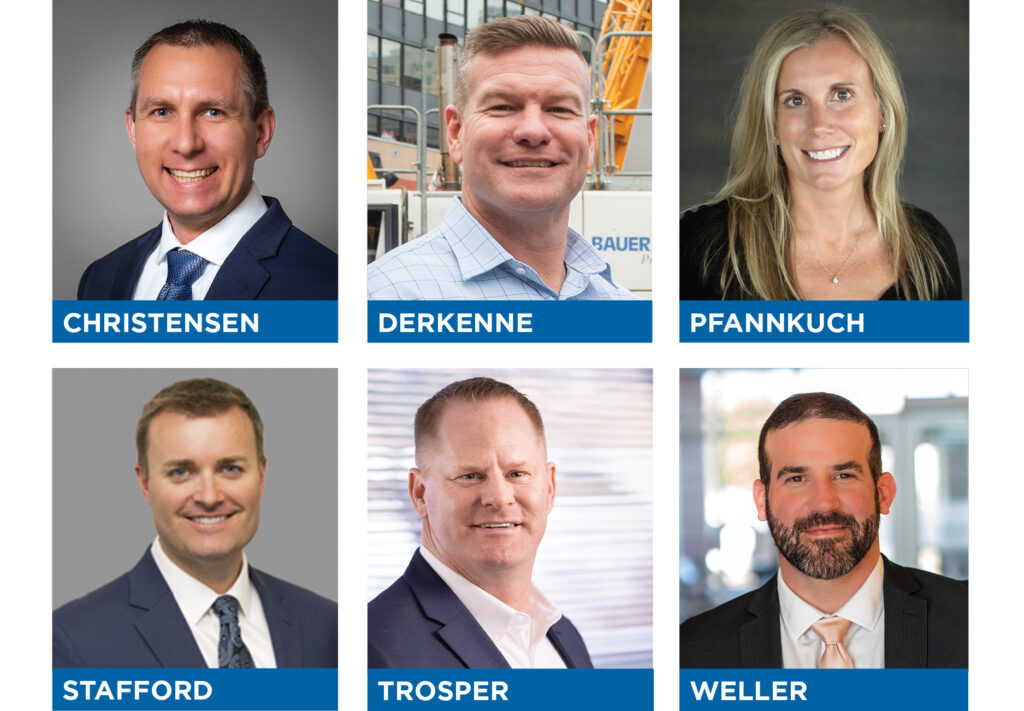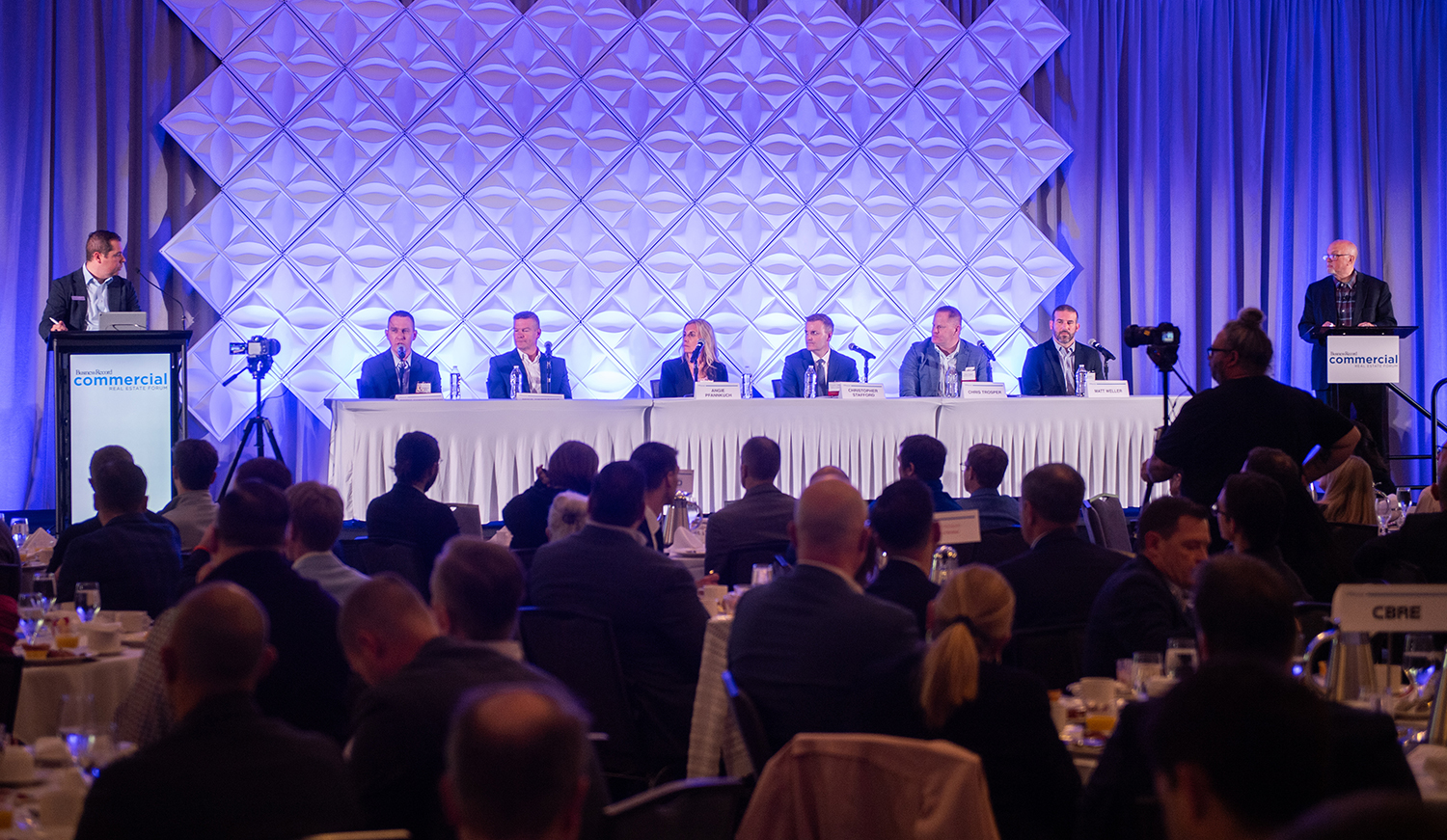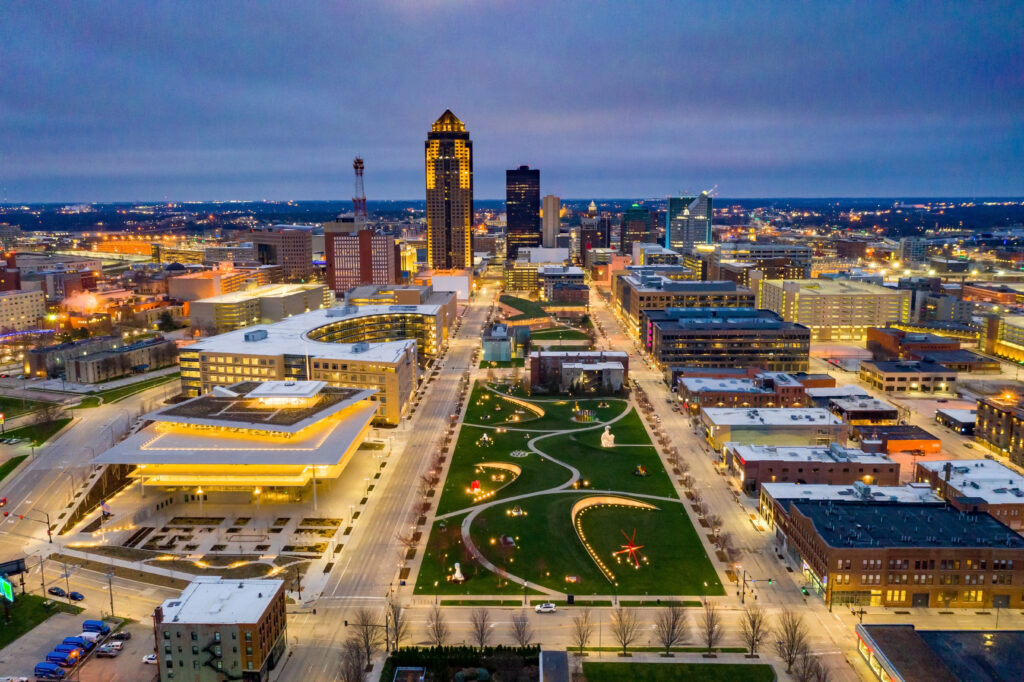What you need to know from the CRE Trends and Issues Forum

Michael Crumb Apr 30, 2025 | 6:00 am
4 min read time
1,013 wordsAll Latest News, Real Estate and DevelopmentDowntown housing, conversion of vacant office space, adaptive reuse and challenges facing the commercial real estate market caused by tariffs, interest rates and uncertainty around changes in the state’s property tax structure.
Those were among the topics discussed during the Business Record’s Commercial Real Estate Trends and Issues Forum held Thursday, April 24, at the Hilton Downtown Des Moines.
Panelists included Cody Christensen, director of development services, city of Des Moines; Mike Derkenne, co-owner of Beal-Derkenne Construction; Christopher Stafford, director and senior vice president, Cushman & Wakefield Iowa Commercial Advisors; Angie Pfannkuch, president, Sidekick Development; Matt Weller, vice president of development, Hubbell Realty Co.; and Chris Trosper, director of real estate development, Opus Development Co. LLC.

The forum also featured Bill Wright, senior vice president at CBRE, receiving the Iowa State University Ivy College of Business Commercial Real Estate Professional of the Year award.
Here are some of the key takeaways from the panel discussion.
Derkenne said he believes the key to a successful downtown is housing.
“The more people we can have living downtown, it’s going to take care of the office situation, it’s going to fill up retail. People want to be downtown,” he said. “I think if we have vertical construction and a product most other cities don’t have, it will attract young professionals. It will attract active adults, empty nesters. People are going to want to be done here and walk to restaurants, walk to concerts and hopefully walk to a new soccer stadium soon as well.”
Pfannkuch is currently working with four cities on public projects. While those projects are fully funded and not affected by changes in the state’s property tax system, it is affecting cities’ operational budgets, she said.
“So, these new facilities we’re building, it’s a concern if they can be staffed,” she said. “With the 2% growth cap, cities are really looking hard at their budgets, and looking at how operations may have to change.”
She said the changes will challenge cities as they continue to try to grow.
“The main thing is trying to keep the staff they have and as these communities are growing, how do they keep building permits going and how do they keep all the developers happy and that there is appropriate staff to keep the process moving,” Pfannkuch said. “It’s hard to grow if you don’t have appropriate staff.”
Another main concern is if cities can continue to provide the services needed to support growth.
“I can build a really nice new fire and police station but [they] can’t hire the people to staff it,” Pfannkuch said.
Stafford said there are signs of stabilization in the office market, although he feels as if it’s been “two steps forward and one step back.”
There has been positive absorption, which has primarily been in the conversion of office space to multifamily, he said.
“There are users out there looking for office space,” Stafford said. “It is an active market.
Whether you look at the suburbs or downtown, there is activity, which is really positive. Deals are taking much longer and clients are 12 to 24 months out in front of their potential lease expirations.”
Sublease activity has “pretty much dried up,” which Stafford said is a healthy sign.
Stafford said he is closely watching development in the Market District and the potential sale of Valley West Mall.
“There’s a lot of exciting projects,” he said. “Things are happening. Des Moines is resilient. It’s strong. Fundamentals are there. We just need to navigate some of these challenges.”
Trosper said the industrial market will likely go through a three-step process.
“In the short term it feels like we’re in price discovery,” he said. “Tariffs have impacted that. Where is that going to land? In the medium term, there’s about 3.5 million square-feet of Class A industrial. If we’re absorbing a million-plus square feet normally, you think it will take three years to get through that.”
He said more of that industrial space needs to be absorbed “to become a healthier industrial market.”
But in the long term, Trosper said the movement to online commerce and getting logistics closer to the customer are positive signs.
“That all feels really good. If you can look past the short-term blips, the fundamentals are there. There’s some wood to chop but that’s how the industrial market feels right now,” he said.
Weller said development strategies are status quo in light of the market’s volatility.
He said post-COVID, investing was paused. Then prices increased, creating uncertainty. Then debt became a problem with increased interest rates. And now it’s insurance and what insurance rates are going to be.
“It’s kind of status quo,” he said. “We try to have as few variables and unknowns as possible, and hedge against what those could do in the future, but there’s always uncertainty and there’s always risk in development, that’s the nature of the business.”
Christensen cast an optimistic tone for the future of commercial real estate in Des Moines, calling it record-breaking activity.
There is new development downtown, he said, conversions of office space to residential, opportunities for adaptive reuse and historic building conversions.
Among the examples he cited were the conversion of Ruan II to residential, the construction of the 515 Walnut Tower as well as the Market District development and four proposals the city has received for development there with some vertical construction possibly occurring later this year.
He also mentioned the recently announced certified site for industrial development on the city’s southeast side, the auction of the federal courthouse and the availability of historic city buildings along the riverfront in the coming years.
Christensen said the county’s request for proposals for the redevelopment of the parking lot at Fifth and Cherry streets attracted four proposals from out-of-state developers.
“What that is telling us is that investors around the country see Des Moines as a safe place to invest,” he said. “That’s a good sign.”
Christensen also said there’s been a lot of activity along the Ingersoll Avenue corridor and in the Beaverdale neighborhood.
“We have a lot going on in Des Moines,” he said.

Michael Crumb
Michael Crumb is a senior staff writer at Business Record. He covers real estate and development and transportation.











